Food for Soul: Lara Gilmore's refettori are no ordinary soup kitchens
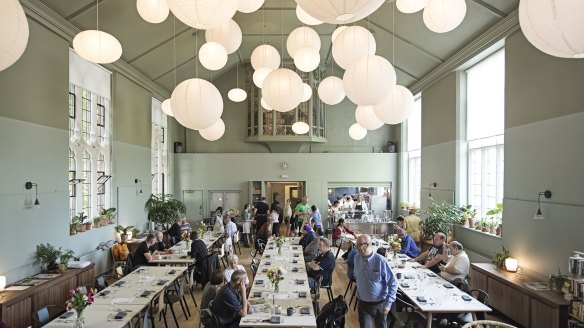
In the ancient crypt beneath La Madeleine church in Paris is a beautiful dining room. Designer plates are set at the wooden tables, the warm glow of small lamps sets off translucent clouds that hang from the curved sandstone ceiling. The clouds have been suspended just so by acclaimed French artist JR.
This is a place designed to restore faith, but it is a faith that has little to do with the religion espoused in the church above.
Beyond the dining room a kitchen bustles, preparing for service. The room is full each night, serving a three-course menu that changes daily depending on the available produce. This hidden kitchen has played host to some of the world's best chefs, from Anne-Sophie Pic to Alain Passard, from Alex Atala to Dominique Crenn.
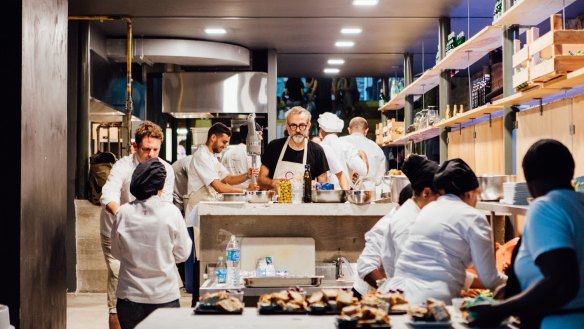
As with all the finest dining rooms around the world, this refettorio is a place where food and hospitality are combined with art and culture.
And yet, these are no ordinary restaurants (now one of four; Refettorio Paris has sister kitchens in Milan, Rio de Janeiro and London). Ostensibly they're soup kitchens, but, again, these are no ordinary soup kitchens. When it comes to Lara Gilmore and her husband Massimo Bottura, co-owners of Osteria Francescana and founders of Food for Soul, we have learnt to expect the unexpected.
"The unspoken can give value and an immediate sense of wellbeing, to seat someone at a beautiful wood table, with silverware and a plate that isn't plastic – it says I trust you, it makes someone feel different. These small details communicate big messages and that can make change happen," Gilmore says.
We are thinking of ways to nourish ourselves and our communities in a better and more impactful way.Lara Gilmore
The "small details" might range from the choice of crockery and cutlery to very large details: from JR's clouds beneath La Madeleine to the dining room in Brazil's Refettorio Gastromotiva – a translucent light box conceived by architect Gustavo Cedroni; the Refettorio Ambosiano in Milan boasts a different designer for each one of her 13 tables – the tables created by some of Italy's most distinguished and most famous artists, architects and designers. They are works of art, they are also places to break bread.
Behind the beauty, the refettori (community kitchens) are making use of tonnes of surplus food – perfectly edible produce donated from markets, supermarkets, producers and suppliers, in various stages of ripeness. With a little culinary creativity, it is transformed for these community kitchens, places that welcome people in situations of social vulnerability or those who feel isolated, or marginalised, in their community.
Food for health, beauty for faith.
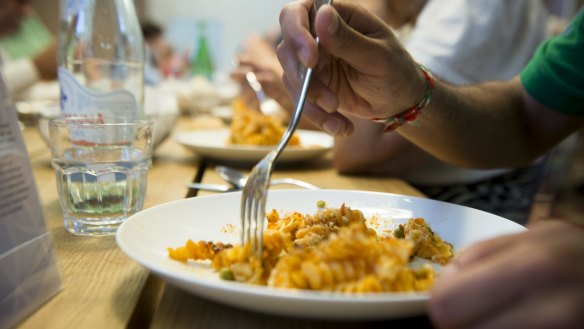
The idea behind the refettori was conceived four years ago for the Milan Expo. Gilmore and Bottura were focused on addressing what they see as two sides of the same coin: rescuing the surplus food (we are still, collectively, throwing out one third of all that we produce) and addressing social injustice in food (it is estimated food insecurity affects some 815 million – 11 per cent of the global population). However, they wanted to add a third element – the value of that which is beautiful.
"It begins with respect and beauty and dignity for our guests and our diners," explains Gilmore, "but also having respect for food … there's so much food that is thrown away that can easily be turned into a delicious meal in a welcoming atmosphere."
For inspiration, they gathered friends (with friends like Rene Redzepi, Ana Ros, Joan Roca, the kitchen was in the hands of some of our generation's best and most contemporary) and then, they encouraged them to turn their cooking on its head; they were to look back to the simple peasant cooking of the past. La cucina povera was to be the muse, the Italian matriarchs the inspiration.
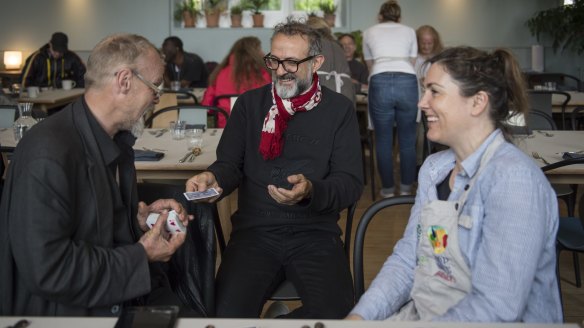
"We looked to the grandmothers and aunts," says Gilmore, "the women who used to hold the money for the household and the family … they used every part of the product, recovering it from the day before – the peel, celery tops, bread – food was never thrown away."
Bread, for example, might be served fresh on day one, be found in the bottom of a bowl of restorative soup or a panzanella salad on day two, and by day three it will be made into breadcrumbs for meatballs or passatelli.
They also gathered artists and designers. At the top end of the town that attention to detail and whimsy is an expectation: carefully chosen artworks, comfortable chairs, thoughtful lighting. Of course, when running a charity, cost is often a prohibitive factor – beauty is hard to quantify on a spreadsheet – however, this was never going to be a charity project. It was a cultural one.
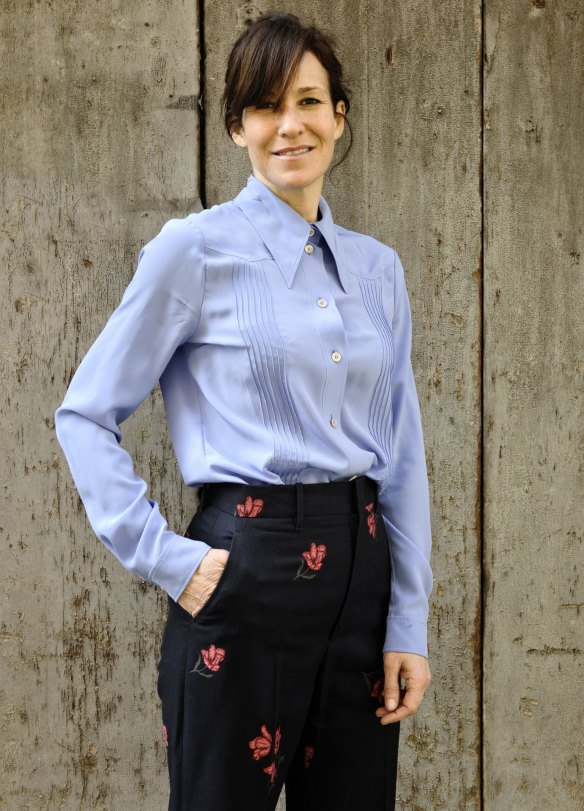
And, while you won't find dishes like "Memory of a Mortadella Sandwich" or "An Eel Swimming up the Po River" – dishes that have taken Bottura's Osteria Francescana to the No. 1 spot on the World's 50 Best, where it has hovered for much of the past decade – you will find many examples of the combination of food, art and hospitality that the restaurant is renowned for.
For American-born Gilmore, whose background is in the art world and theatre, the impact and emotional response to aesthetics is second nature and so, when the couple opened Osteria Francescana in 1995, it was created with the same collaboration between one's art and the other's food, between the story and the story-telling.
When the pair married a few months later, Bottura cooked for the 200 guests and Gilmore saw to the aesthetics. The collaboration continued and two children followed. Beyond the poetry in their food, and art in their dining rooms, the pair have long been fascinated with the power of food and beauty to evoke change.
"A lot of things happened along the way," recounts Gilmore. "There were difficulties to convince the critics and townspeople that we weren't trying to be irreverent. While at home, we were also raising a son with difficulties – it took us outside of our ego. It was our springboard to think ethically, it's not just about the kitchen but the community that you live in.
"Food can be a powerful tool for change, to show love and kindness," continues Gilmore. "We went through some pretty superficial times – all luxury ingredients and molecular cooking – but now there's a tide, an important one of ethical thinking, and we are thinking of ways to nourish ourselves and our communities in a better and more impactful way."
Both Gilmore and Bottura are dedicated to acting when they see the opportunity. Their son, Charlie, is now 18. Born with a rare genetic syndrome, he has been the inspiration behind Gilmore's new project, Il Tortellante. It, too, takes the women and the traditions of Modena as its genesis. Instead of celebrity chefs, the tortellanti (pasta-makers) are turning to the original custodians of kitchen traditions in Italy – in this case the rezdora ("the grandmother who rolls pasta" in the Modenese dialect.)
What started as an afternoon activity with a group of adults with young special needs, learning to make tortellini has turned into something much bigger. "It's a bridge between school and life for a whole sector of society. It now means to contribute positivity, it's a job but also sense of identity."
"For the rezdora, it was a chance to finally pass on what they knew to someone who was not only interested, but looking for an identity, for a skill, for a future. The teens were seeing themselves as part of a group, having a name; they were proud to walk around with their hats and aprons, to be tortellanti."
The tortellanti are now making more than they can take home, a laboratory has been opened, orders are being taken – already more than they can fulfil.
In fact, there's not much Gilmore thinks food and art can't do. It's an act of love, it's a call to act, it's power. There is proof in the pudding: the collective work of the refettori has saved more than 45 tonnes of food and fed an estimated 150,000, with the help of some 830 volunteers.
Meanwhile, the community around the refettori continues to thrive and grow. They are opening around the world with the help of partners, chefs, artists and local communities. While the pair have a number of potential destinations on the horizon – from Mexico to the States – they remain adamant that each project should be unique, based on the community's individual needs.
"We realised we didn't need names of fancy chefs behind us, the community had taken hold of it, now we are over-booked with volunteers," says Gilmore. "Food has a power to change people's mind. It has a very big cultural impact on a city."
The reach extends beyond the community kitchens, too. "It is one thing to serve 100 people a day, but so much more powerful that it goes to every household – the way we think of food, how we buy it, cook it. The need for community kitchens is obvious and necessary, but to go beyond that, to learn and take it home, is something else."
And so it was, late last month, as the Refettorio was welcoming guests in the crypt of La Madeleine, that across town Paris was playing host to a number of the world's culinary stars. It was the inaugural World Restaurant Awards and Gilmore was there to accept an award, not for their fine dining restaurant in Modena, but for the ethical thinking applied to their community kitchens, now scattered across the globe.
Surrounded by the who's who of the restaurant world, many of whom have donated their time to cook in the refettori, the award was a big honour shared among big names and great friends.
"We are among a generation of chefs and restaurateurs who are re-addressing issues that are important to the whole world, not just the restaurant industry, [those who] think that with our actions every day in the kitchen we can makes a small amount of change for good."
It is a powerful idea. It is also a beautiful one.
"The fork
the knife
the spoon
on the napkin
on the table
I'm touched
It's all for me"
- Rita, February 2019, Refettorio Gastromotiva
Other women to watch
At the annual Parabere Forum in Oslo this week, women in food – from 35 different countries – have gathered to talk about how food can empower and change the game. Among the movers and shakers:
Ragnhild Slettner
Working with refugees in Oslo, Slettner aims to help those in need with the qualifications (and navigation through red tape) required to get food businesses off the ground.
For Slettner, it is all about appreciating and embracing their incredible knowledge.
"Nobody asks them what they would like to do, what their dreams are," she says.
At Vippa Oslo (a food, education and cultural centre) projects and ideas are given a space to flourish and food is served from little restaurants to the Oslo community.
Alice Waters
Looking beyond the organic principles and the small producers she has advocated in her restaurant for nearly 50 years, Waters founded The Edible Schoolyard Project with a view to bringing that education to American children.
This "edible education" has spread to a number of schools across America. Waters is now turning her attention to the classroom and curriculum ... watch this space!
Cristina RenI
Venezuelan-born Reni is the executive director of Food for Soul. Reni is the one with her feet on the ground bringing together the many facets that make up this non-profit business.
Food for Soul is looking for more sites in other countries.
Restaurant reviews, news and the hottest openings served to your inbox.
Sign up- More:
- Restaurant news